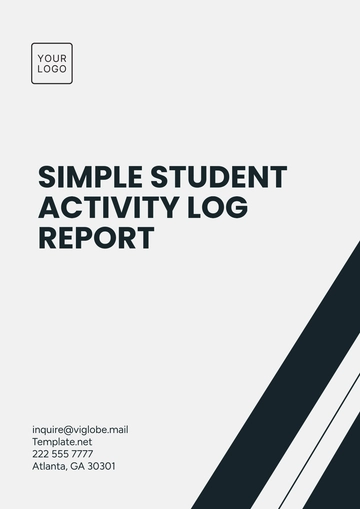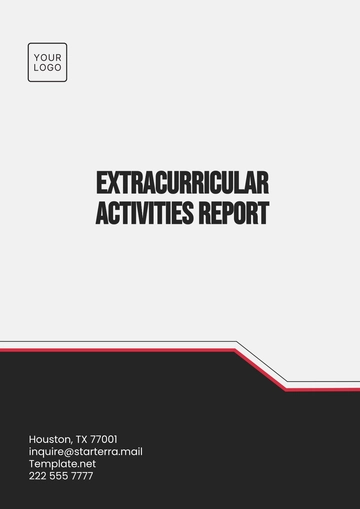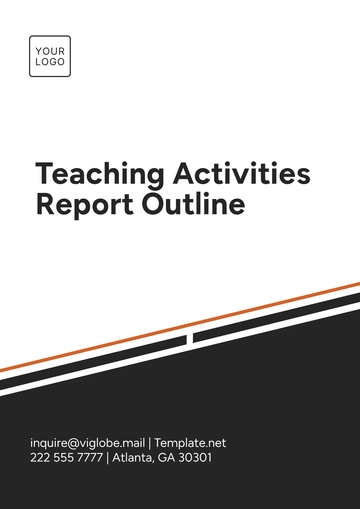Free Child Care Daily Activity Report

I. Child Information
Child's Full Name: [Child's Name]
[Child's Name] is a bright and inquisitive 3-year-old child who enjoys exploring new concepts through play. Today’s report reflects the child's interactions, activities, and overall emotional state throughout the day. The child participated actively in both structured and free play, showing increasing curiosity in learning new things. [Child's Name] is steadily developing social and emotional skills, which are observed through their engagement with peers and teachers.
Date of Report: December 20, 2050
The report is based on observations made throughout the day, from morning arrival at 7:00 AM until pick-up at 6:00 PM. This provides a comprehensive look at the child's progress, challenges, and highlights from today’s routine.
Age/Grade Level: 3 Years Old
At this developmental stage, [Child's Name] is beginning to expand their vocabulary, improve motor skills, and develop social interactions. The child is enrolled in the Pre-Kindergarten program, where activities are tailored to promote early cognitive, physical, and social development.
Teacher's Name: [Teacher's Name]
[Teacher's Name] has been working with [Child's Name] for six months and is well-acquainted with their individual learning needs and personality. The teacher provides a nurturing environment, guiding [Child's Name] through various activities that support growth in multiple developmental areas.
II. Caregiver Information
Name of Primary Caregiver: [Teacher's Name]
[Teacher's Name] is the primary caregiver for today’s session, responsible for guiding [Child's Name] through daily activities. The caregiver has extensive experience working with young children and focuses on fostering a supportive and engaging learning environment.
Shift or Hours Worked: 7:00 AM – 6:00 PM
The caregiver worked a full-day shift, overseeing all aspects of [Child's Name]'s routine, including meals, naps, learning activities, and emotional support. [Teacher's Name] ensured that [Child's Name] felt safe, comfortable, and encouraged to participate throughout the day.
Contact Information: [Teacher's Number]
In case of emergencies or if parents wish to discuss any aspect of the child’s day, they can contact [Teacher's Name] directly at [Teacher's Number]. The caregiver also provides timely updates to parents during pickup and drop-off times to ensure open communication.
Caregiver’s Professional Experience
[Teacher's Name] has been working with young children for over five years, specializing in early childhood education. They are skilled in observing and understanding the developmental needs of children, adjusting daily activities to match each child’s unique pace and interests.
III. Daily Routine and Activities
A. Meals and Snacks
Breakfast: 7:30 AM: Oatmeal with strawberries and milk. [Child's Name] ate almost all of the oatmeal and enjoyed the fresh fruit, showing a preference for the strawberries.
Morning Snack: 10:00 AM: Apple slices and crackers. Ate around 80% of the snack and had some difficulty finishing the apple slices, likely due to their firm texture.
Lunch: 12:30 PM: Chicken, rice, and peas. Ate all the rice and chicken, but only a few peas, expressing preference for the rice.
Afternoon Snack: 3:30 PM: Yogurt with granola. Finished most of the snack but needed some encouragement to eat the yogurt as it was slightly thicker than preferred.
Meal Time | Food Items | Amount Eaten |
|---|---|---|
Breakfast | Oatmeal with strawberries and milk | 90% |
Morning Snack | Apple slices and crackers | 80% |
Lunch | Chicken, rice, and peas | 85% |
Afternoon Snack | Yogurt with granola | 75% |
B. Nap/Rest Period
Nap Start and End Time: 1:30 PM – 3:00 PM
[Child's Name] settled down quickly after a brief story to help with relaxation. After some initial restlessness, they fell into a peaceful sleep for the majority of the nap time. The child woke up refreshed and ready to engage in post-nap activities.
C. Diapering or Potty Breaks
Potty Usage: Used the toilet independently at 9:00 AM and 3:30 PM. [Child's Name] is progressing well in potty training and has started to initiate bathroom breaks. There were no accidents today, indicating improvement in self-regulation.
Health-Related Notes: The child did not show any signs of discomfort or irritation during the potty breaks.
IV. Behavior and Emotional Development
A. General Mood
Emotional State: [Child's Name] displayed a happy and energetic mood for most of the day, showing excitement during outdoor play. However, they became a bit irritable when transitioning from one activity to another, particularly when it was time to clean up.
Signs of Distress: Experienced minor frustration when asked to leave the play area, but recovered quickly after being comforted.
Behavior Patterns: Overall cooperative and eager to engage in activities, though at times needed gentle reminders to follow directions.
B. Peer Interactions
Social Engagement: [Child's Name] interacted positively with peers, particularly during group play with building blocks. They shared toys with [Peer’s Name] and seemed eager to cooperate.
Conflicts or Challenges: Had a brief disagreement with [Peer’s Name] over a toy car, but quickly learned to take turns after teacher intervention.
Social Skills Development: Demonstrated an increasing ability to share and take turns, engaging in cooperative play for extended periods.
C. Caregiver Interactions
Behavior Towards Teacher: [Child's Name] showed affection and asked for help when cleaning up. The child responded well to praise for good behavior, seeking further approval.
Helpfulness and Cooperation: Willingly assisted with tidying up after activities and helped pass out materials for group work.
Reactions to Instructions: Generally follows instructions with minor hesitation, particularly when the activity requires transitioning between tasks.
V. Educational and Cognitive Development
A. Learning Activities
Group Activities: Participated enthusiastically in a group storytime, especially enjoying "The Very Hungry Caterpillar." [Child's Name] was able to recall the sequence of events and interacted with the story by pointing to pictures.
Individual Activities: Worked on a jigsaw puzzle independently, completing a 12-piece puzzle with little assistance. This task helped strengthen their problem-solving skills.
Cognitive Skills: Demonstrated an understanding of basic concepts like counting and recognizing colors, successfully identifying objects in the puzzle based on color.
B. Play-Based Learning
Free Play: Engaged in imaginative play in the dramatic play area, pretending to be a chef and serving meals to peers. This play promoted creativity and social interaction.
Structured Play: Actively participated in a circle game of "Simon Says," following the rules and performing actions like clapping and jumping.
Problem-Solving: Solved simple challenges during free play, such as building a stable tower with blocks that initially kept falling over.
C. Language and Communication
Verbal Communication: [Child's Name] used complete sentences, such as "I want to play with blocks" and "Can I have more juice?"
Non-Verbal Communication: Pointed to the snack table when hungry and gestured for assistance when reaching for high objects.
Listening and Comprehension: Listened attentively to instructions during circle time and was able to follow multi-step directions with minimal prompting.
VI. Physical Development and Activity
A. Gross Motor Skills
Outdoor Activities: Took part in a group game of tag, running around energetically and showing an ability to change direction quickly.
Indoor Activities: Engaged in stretching and balance exercises, attempting to walk along a low balance beam with some assistance.
Motor Skill Progress: Demonstrated improved coordination, successfully hopping on one foot and running with increased stability.
B. Fine Motor Skills
Art and Craft Activities: Enjoyed coloring with crayons, carefully staying within the lines on a picture of a tree.
Manipulative Play: Spent time building a structure using small blocks, successfully stacking them without assistance.
Hand-Eye Coordination: Completed a puzzle independently, placing the pieces in their correct spots without difficulty.
C. Physical Milestones
Notable Developments: Was able to jump over a small hurdle set up during physical activity, showing improved leg strength and coordination.
Health Observations: [Child's Name] appeared to have no fatigue or discomfort, maintaining energy throughout the day.
Participation: Participated enthusiastically in all physical activities, especially running and jumping games.
VII. Health and Safety
A. Health Observations
Physical Symptoms | No signs of illness or physical distress. [Child's Name] was active and energetic throughout the day. |
Medication Administered | None. |
Medical or Dietary Restrictions | None reported today. |
B. Safety and Accidents
Incidents or Injuries | No injuries were reported today. |
First Aid Measures | None required. |
Precautions or Safety Concerns | All safety protocols were followed during outdoor play and mealtime. |
C. Sanitation and Hygiene
Hand Washing | Was assisted in washing hands before meals and after using the restroom. |
Diaper Changes or Potty Breaks | [Child's Name] used the potty independently twice with no accidents. |
Observations on Personal Hygiene | The child remained clean and well-groomed throughout the day, with a healthy interest in personal hygiene. |
VIII. Special Notes and Observations
A. Child’s Interests and Preferences
Favorite Activities: [Child's Name] particularly enjoyed free play in the dramatic play area and the art station.
Notable Enjoyments: Showed great enthusiasm for the puzzle and asked to do another one after completing the first.
Engagement with Learning Content: Displayed interest in the story "The Very Hungry Caterpillar," pointing to the food items and repeating some of the words.
B. Behavioral Concerns or Challenges
Difficulty with Transitions: [Child's Name] had difficulty transitioning from outdoor play back into the classroom, but managed after a short calming routine.
Emotional Outbursts: There were no significant emotional outbursts today.
Other Behavioral Issues: None observed.
C. Parent Communication
Conversations with Parents: Parents were informed about [Child's Name]'s positive interactions with peers and the difficulty transitioning after outdoor play.
Parent Requests or Concerns: Parents requested an update on potty training progress, which is going well.
Teacher's Recommendations for Home Follow-Up: Continue to encourage routines for transitions and self-care activities at home.
IX. Conclusion
The day’s activities and observations indicate that [Child's Name] had a generally positive and productive experience. Despite minor challenges with activity transitions, [Child's Name] showed resilience and adaptability, progressing socially and emotionally, especially in peer interactions and learning. Their enthusiasm for group play and activities is clear, and nurturing these aspects will support further growth.
A. Areas for Continued Focus
While [Child's Name] is making great strides, further support in managing transitions between activities could be helpful. It would be beneficial to implement strategies that help [Child's Name] adjust smoothly from one activity to another, such as offering gentle reminders or countdowns before transitioning. Additionally, more opportunities for cooperative play with peers can foster improved social skills, especially in group settings. Encouraging the child to express their emotions verbally when frustrated could also contribute to emotional development.
B. Next Steps and Recommendations
Moving forward, the focus will be on reinforcing positive potty training habits, as well as encouraging independent choices during playtime. Introducing more structured group activities, like cooperative building tasks or group art projects, may help improve both cognitive and social skills. In the upcoming weeks, we plan to integrate more sensory play opportunities to engage [Child's Name]'s curiosity and creative thinking. Parents can also continue to reinforce similar routines at home to help with emotional regulation and smooth transitions.
- 100% Customizable, free editor
- Access 1 Million+ Templates, photo’s & graphics
- Download or share as a template
- Click and replace photos, graphics, text, backgrounds
- Resize, crop, AI write & more
- Access advanced editor
Ensure a seamless experience with the Child Care Daily Activity Report Template from Template.net. This editable and customizable template is designed to streamline daily reporting, making it easy to track children’s activities, moods, and development. With the built-in AI Editor Tool, you can quickly personalize reports to suit your childcare needs, saving you time and effort.
You may also like
- Sales Report
- Daily Report
- Project Report
- Business Report
- Weekly Report
- Incident Report
- Annual Report
- Report Layout
- Report Design
- Progress Report
- Marketing Report
- Company Report
- Monthly Report
- Audit Report
- Status Report
- School Report
- Reports Hr
- Management Report
- Project Status Report
- Handover Report
- Health And Safety Report
- Restaurant Report
- Construction Report
- Research Report
- Evaluation Report
- Investigation Report
- Employee Report
- Advertising Report
- Weekly Status Report
- Project Management Report
- Finance Report
- Service Report
- Technical Report
- Meeting Report
- Quarterly Report
- Inspection Report
- Medical Report
- Test Report
- Summary Report
- Inventory Report
- Valuation Report
- Operations Report
- Payroll Report
- Training Report
- Job Report
- Case Report
- Performance Report
- Board Report
- Internal Audit Report
- Student Report
- Monthly Management Report
- Small Business Report
- Accident Report
- Call Center Report
- Activity Report
- IT and Software Report
- Internship Report
- Visit Report
- Product Report
- Book Report
- Property Report
- Recruitment Report
- University Report
- Event Report
- SEO Report
- Conference Report
- Narrative Report
- Nursing Home Report
- Preschool Report
- Call Report
- Customer Report
- Employee Incident Report
- Accomplishment Report
- Social Media Report
- Work From Home Report
- Security Report
- Damage Report
- Quality Report
- Internal Report
- Nurse Report
- Real Estate Report
- Hotel Report
- Equipment Report
- Credit Report
- Field Report
- Non Profit Report
- Maintenance Report
- News Report
- Survey Report
- Executive Report
- Law Firm Report
- Advertising Agency Report
- Interior Design Report
- Travel Agency Report
- Stock Report
- Salon Report
- Bug Report
- Workplace Report
- Action Report
- Investor Report
- Cleaning Services Report
- Consulting Report
- Freelancer Report
- Site Visit Report
- Trip Report
- Classroom Observation Report
- Vehicle Report
- Final Report
- Software Report




























